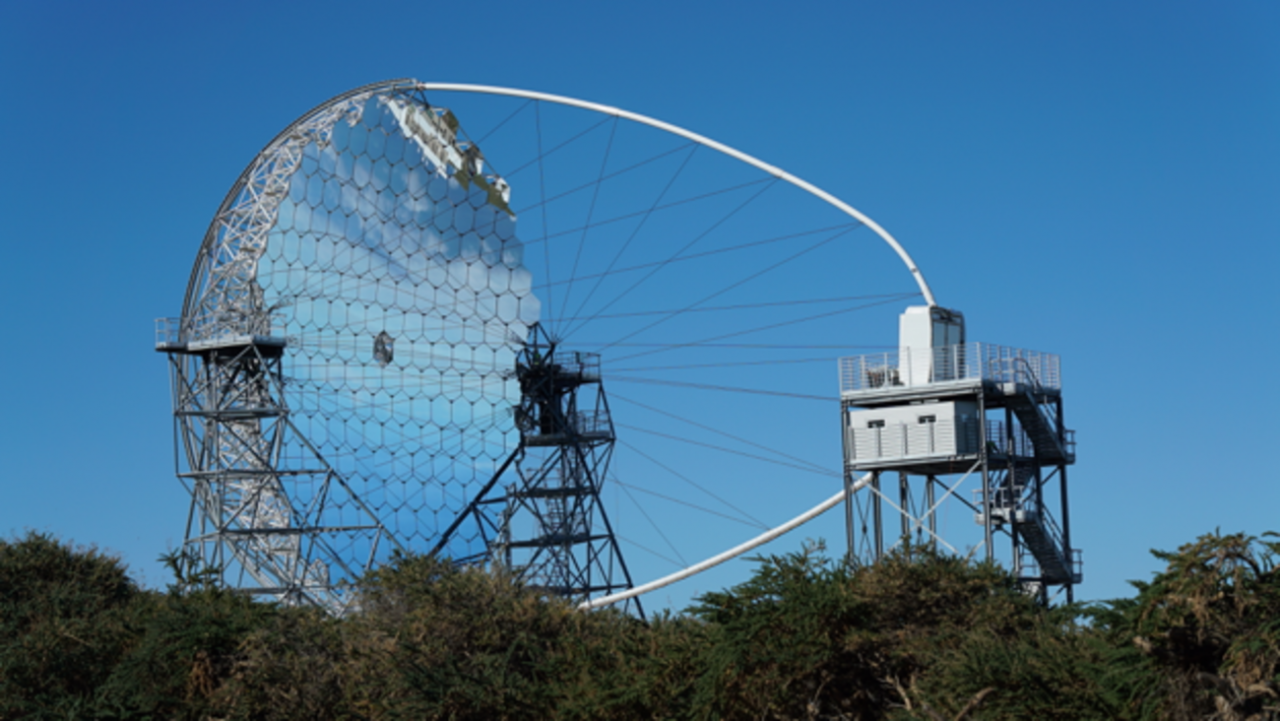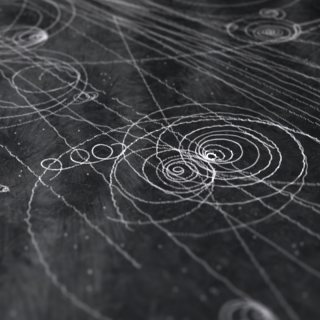Grants related:
General
The MAGIC Collaboration is integrated by 20 research institutes and university departments from Armenia, Bulgaria, Finland, Germany, Italy, Poland, Spain, Switzerland and USA. The collaboration comprises two 17m diameter telescopes, located at the Roque de los Muchachos Observatory, designed to measure the Cherenkov radiation associated with atmospheric showers from very high-energy gamma rays.
CTA is a major international collaboration for building two large Cherenkov observatories at North and South Hemispheres. Roque de los Muchachos Observatory in La Palma has been selected to host the Northern observatory. The first large size telescope was inaugurated in October 2018, and we are presently building the other three.
Members
Results
- Inauguration of the first large-size telescope of CTA (LST-1) at the Observatorio del Roque de Los Muchachos
- Detection of a neutrino generated in a blazar with MAGIC, IcCube and Fermi-LAT
- Discovery of the binary systemPSR J2032+4127/MT91 213 emitting in VHE gamma rays.
Scientific activity
Related publications
-
High Statistics Measurement of the Positron Fraction in Primary Cosmic Rays of 0.5-500 GeV with the Alpha Magnetic Spectrometer on the International Space Station
A precision measurement by AMS of the positron fraction in primary cosmic rays in the energy range from 0.5 to 500 GeV based on 10.9 million positron and electron events is presented. This measurement extends the energy range of our previous observation and increases its precision. The new results show, for the first time, that above ∼200 GeV the
Accardo, L. et al.Advertised on:
92014 -
MAGIC observations and multifrequency properties of the flat spectrum radio quasar 3C 279 in 2011
Aims: We study the multifrequency emission and spectral properties of the quasar3C 279 aimed at identifying the radiation processes taking place in the source. Methods: We observed 3C 279 in very-high-energy (VHE, E> 100 GeV) γ-rays, with the MAGIC telescopes during 2011, for the first time in stereoscopic mode. We combined these measurements with
Sitarek, J. et al.Advertised on:
72014 -
MAGIC long-term study of the distant TeV blazar PKS 1424+240 in a multiwavelength context
Aims: We present a study of the very high-energy (VHE; E> 100 GeV) γ-ray emission of the blazar PKS 1424+240 observed with the MAGIC telescopes. The primary aim of this paper is the multiwavelength spectral characterization and modeling of this blazar, which is made particularly interesting by the recent discovery of a lower limit of its redshift
Miranda, J. M. et al.Advertised on:
72014 -
First broadband characterization and redshift determination of the VHE blazar MAGIC J2001+439
Aims: We aim to characterize the broadband emission from 2FGL J2001.1+4352, which has been associated with the unknown-redshift blazar MG4 J200112+4352. Based on its gamma-ray spectral properties, it was identified as a potential very high energy (VHE; E> 100 GeV) gamma-ray emitter. We investigate whether this object is aVHE emitter, characterize
Aleksić, J. et al.Advertised on:
122014 -
Multiwavelength observations of Mrk 501 in 2008
Context. Blazars are variable sources on various timescales over a broad energy range spanning from radio to very high energy (>100 GeV, hereafter VHE). Mrk 501 is one of the brightest blazars at TeV energies and has been extensively studied since its first VHE detection in 1996. However, most of the γ-ray studies performed on Mrk 501 during the
Aleksić, J. et al.Advertised on:
12015 -
Discovery of very high energy γ-ray emission from the blazar 1ES 0033+595 by the MAGIC telescopes
The number of known very high energy (VHE) blazars is ˜50, which is very small in comparison to the number of blazars detected in other frequencies. This situation is a handicap for population studies of blazars, which emit about half of their luminosity in the γ-ray domain. Moreover, VHE blazars, if distant, allow for the study of the environment
Aleksić, J. et al.Advertised on:
12015 -
The Cherenkov Telescope Array potential for the study of young supernova remnants
Supernova remnants (SNRs) are among the most important targets for γ-ray observatories. Being prominent non-thermal sources, they are very likely responsible for the acceleration of the bulk of Galactic cosmic rays (CRs). To firmly establish the SNR paradigm for the origin of cosmic rays, it should be confirmed that protons are indeed accelerated
Acharya, B. S. et al.Advertised on:
32015 -
The upgraded MAGIC Cherenkov telescopes
The MAGIC Cherenkov telescopes underwent a major upgrade in 2011 and 2012. A new 1039-pixel camera and a larger area digital trigger system were installed in MAGIC-I, making it essentially identical to the newer MAGIC-II telescope. The readout systems of both telescopes were also upgraded, with fully programmable receiver boards and DRS4-chip-based
Tescaro, D.Advertised on:
122014 -
Precision Measurement of the (e++e-) Flux in Primary Cosmic Rays from 0.5 GeV to 1 TeV with the Alpha Magnetic Spectrometer on the International Space Station
We present a measurement of the cosmic ray (e++e-) flux in the range 0.5 GeV to 1 TeV based on the analysis of 10.6 million (e++e-) events collected by AMS. The statistics and the resolution of AMS provide a precision measurement of the flux. The flux is smooth and reveals new and distinct information. Above 30.2 GeV, the flux can be described by a
Aguilar, M. et al.Advertised on:
112014 -
Black hole lightning due to particle acceleration at subhorizon scales
Supermassive black holes with masses of millions to billions of solar masses are commonly found in the centers of galaxies. Astronomers seek to image jet formation using radio interferometry but still suffer from insufficient angular resolution. An alternative method to resolve small structures is to measure the time variability of their emission
Aleksić, J. et al.Advertised on:
112014 -
MAGIC reveals a complex morphology within the unidentified gamma-ray source HESS J1857+026
Aims: HESS J1857+026 is an extended TeV gamma-ray source that was discovered by H.E.S.S. as part of its Galactic plane survey. Given its broadband spectral energy distribution and its spatial coincidence with the young energetic pulsar PSR J1856+0245, the source has been put forward as a pulsar wind nebula (PWN) candidate. MAGIC has performed
MAGIC Collaboration et al.Advertised on:
112014 -
Electron and Positron Fluxes in Primary Cosmic Rays Measured with the Alpha Magnetic Spectrometer on the International Space Station
Precision measurements by the Alpha Magnetic Spectrometer on the International Space Station of the primary cosmic-ray electron flux in the range 0.5 to 700 GeV and the positron flux in the range 0.5 to 500 GeV are presented. The electron flux and the positron flux each require a description beyond a single power-law spectrum. Both the electron
Aguilar, M. et al.Advertised on:
92014 -
MAGIC gamma-ray and multi-frequency observations of flat spectrum radio quasar PKS 1510-089 in early 2012
Aims: Amongst more than fifty blazars detected in very high energy (VHE, E> 100 GeV) γ rays, only three belong to the subclass of flat spectrum radio quasars (FSRQs). The detection of FSRQs in the VHE range is challenging, mainly because of their soft spectra in the GeV-TeV regime. MAGIC observed PKS 1510-089 (z = 0.36) starting 2012 February 3
Aleksić, J. et al.Advertised on:
92014 -
MAGIC search for VHE γ-ray emission from AE Aquarii in a multiwavelength context
Context. It has been claimed that the nova-like cataclysmic variable AE Aquarii (AE Aqr) is a very-high-energy (VHE, E> 100 GeV) source both on observational and theoretical grounds. Aims: We search for VHE γ-ray emission from AE Aqr during different states of the source at several wavelengths to confirm or rule out previous claims of detection of
Aleksić, J. et al.Advertised on:
82014 -
Discovery of TeV γ-ray emission from the pulsar wind nebula 3C 58 by MAGIC
Context. The pulsar wind nebula (PWN) 3C 58 is one of the historical very high-energy (VHE; E> 100 GeV) γ-ray source candidates. It is energized by one of the highest spin-down power pulsars known (5% of Crab pulsar) and it has been compared with the Crab nebula because of their morphological similarities. This object was previously observed by
Aleksić, J. et al.Advertised on:
72014 -
Detection of bridge emission above 50 GeV from the Crab pulsar with the MAGIC telescopes
Context. The Crab pulsar is the only astronomical pulsed source detected at very high energy (VHE, E > 100 GeV) gamma rays. The emission mechanism of VHE pulsation is not yet fully understood, although several theoretical models have been proposed. Aims: In order to test new models, we measured the light curve and the spectra of the Crab pulsar
Aleksić, J. et al.Advertised on:
52014 -
Multifrequency Studies of the Peculiar Quasar 4C +21.35 during the 2010 Flaring Activity
The discovery of rapidly variable Very High Energy (VHE; E > 100 GeV) γ-ray emission from 4C +21.35 (PKS 1222+216) by MAGIC on 2010 June 17, triggered by the high activity detected by the Fermi Large Area Telescope (LAT) in high energy (HE; E > 100 MeV) γ-rays, poses intriguing questions on the location of the γ-ray emitting region in this flat
Ackermann, M. et al.Advertised on:
52014 -
Search for very high energy gamma-rays from the z = 0.896 quasar 4C +55.17 with the MAGIC telescopes
The bright gamma-ray quasar 4C +55.17 is a distant source (z = 0.896) with a hard spectrum at GeV energies as observed by the Large Area Telescope (LAT) on board the Fermi satellite. This source is identified as a good source candidate for very high energy (VHE; >30 GeV) gamma-rays. In general, VHE gamma-rays from distant sources provide a unique
Aleksić, J. et al.Advertised on:
32014 -
Contemporaneous observations of the radio galaxy NGC 1275 from radio to very high energy γ-rays
Aims: The radio galaxy NGC 1275, recently identified as a very high energy (VHE, >100 GeV) γ-ray emitter by MAGIC, is one of the few non-blazar active galactic nuclei detected in the VHE regime. The purpose of this work is to better understand the origin of the γ-ray emission and locate it within the galaxy. Methods: We studied contemporaneous
Aleksić, J. et al.Advertised on:
42014 -
Discovery of very high energy gamma-ray emission from the blazar 1ES 1727+502 with the MAGIC Telescopes
Motivated by the prediction of a high TeV luminosity we investigated whether the blazar 1ES 1727+502 (z = 0.055) is emitting very high energy (VHE, E > 100 GeV) γ rays. We observed the BL Lac object 1ES 1727+502 in stereoscopic mode with the two MAGIC telescopes for 14 nights between May 6th and June 10th 2011, for a total effective observing time
Aleksić, J. et al.Advertised on:
32014



